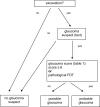The Evonik-Mainz Eye Care-Study (EMECS): Development of an Expert System for Glaucoma Risk Detection in a Working Population
- PMID: 27479301
- PMCID: PMC4968826
- DOI: 10.1371/journal.pone.0158824
The Evonik-Mainz Eye Care-Study (EMECS): Development of an Expert System for Glaucoma Risk Detection in a Working Population
Abstract
Purpose: To develop an expert system for glaucoma screening in a working population based on a human expert procedure using images of optic nerve head (ONH), visual field (frequency doubling technology, FDT) and intraocular pressure (IOP).
Methods: 4167 of 13037 (32%) employees between 40 and 65 years of Evonik Industries were screened. An experienced glaucoma expert (JW) assessed papilla parameters and evaluated all individual screening results. His classification into "no glaucoma", "possible glaucoma" and "probable glaucoma" was defined as "gold standard". A screening model was developed which was tested versus the gold-standard. This model took into account the assessment of the ONH. Values and relationships of CDR and IOP and the FDT were considered additionally and a glaucoma score was generated. The structure of the screening model was specified a priori whereas values of the parameters were chosen post-hoc to optimize sensitivity and specificity of the algorithm. Simple screening models based on IOP and / or FDT were investigated for comparison.
Results: 111 persons (2.66%) were classified as glaucoma suspects, thereof 13 (0.31%) as probable and 98 (2.35%) as possible glaucoma suspects by the expert. Re-evaluation by the screening model revealed a sensitivity of 83.8% and a specificity of 99.6% for all glaucoma suspects. The positive predictive value of the model was 80.2%, the negative predictive value 99.6%. Simple screening models showed insufficient diagnostic accuracy.
Conclusion: Adjustment of ONH and symmetry parameters with respect to excavation and IOP in an expert system produced sufficiently satisfying diagnostic accuracy. This screening model seems to be applicable in such a working population with relatively low age and low glaucoma prevalence. Different experts should validate the model in different populations.
Conflict of interest statement
Figures
Similar articles
-
Glaucoma diagnostics.Acta Ophthalmol. 2013 Feb;91 Thesis 1:1-32. doi: 10.1111/aos.12072. Acta Ophthalmol. 2013. PMID: 23384049
-
Prevalence of glaucoma in Canada: results from the 2016-2019 Canadian Health Measures Survey.Can J Ophthalmol. 2025 Jun;60(3):141-149. doi: 10.1016/j.jcjo.2024.08.016. Epub 2024 Sep 20. Can J Ophthalmol. 2025. PMID: 39313018
-
Performance of frequency-doubling technology perimetry in a population-based prevalence survey of glaucoma: the Tajimi study.Ophthalmology. 2007 Jan;114(1):27-32. doi: 10.1016/j.ophtha.2006.06.041. Epub 2006 Oct 27. Ophthalmology. 2007. PMID: 17070580
-
Predictive value of frequency doubling technology perimetry for detecting glaucoma in a developing country.J Glaucoma. 2005 Apr;14(2):128-34. doi: 10.1097/01.ijg.0000151883.07232.54. J Glaucoma. 2005. PMID: 15741814
-
The role of clinical examination of the optic nerve head in glaucoma today.Curr Opin Ophthalmol. 2021 Mar 1;32(2):83-91. doi: 10.1097/ICU.0000000000000734. Curr Opin Ophthalmol. 2021. PMID: 33470671 Review.
Cited by
-
Glaucoma screening in Kazakhstan.Sci Rep. 2025 Aug 14;15(1):29893. doi: 10.1038/s41598-025-12540-3. Sci Rep. 2025. PMID: 40813384 Free PMC article.
References
-
- Gordon MO, Beiser JA, Brandt JD, Heuer DK, Higginbotham EJ, et al. (2002) The Ocular Hypertension Treatment Study: baseline factors that predict the onset of primary open-angle glaucoma. Arch Ophthalmol 120: 714–720; discussion 829–730. - PubMed
-
- COLLABORATIVE-NORMAL-TENSION-GLAUCOMA-STUDY-GROUP (1998) The effectiveness of intraocular pressure reduction in the treatment of normal-tension glaucoma. Collaborative Normal-Tension Glaucoma Study Group. Am J Ophthalmol 126: 498–505. - PubMed
-
- Quigley HA (1982) Glaucoma's optic nerve damage: changing clinical perspectives. Ann Ophthalmol 14: 611–612. - PubMed
-
- Pfeiffer N, Krieglstein GK, Wellek S (2002) Knowledge about glaucoma in the unselected population: a German survey. J Glaucoma 11: 458–463. - PubMed
MeSH terms
LinkOut - more resources
Full Text Sources
Other Literature Sources
Medical


